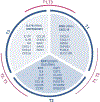Endotypes of chronic rhinosinusitis: Relationships to disease phenotypes, pathogenesis, clinical findings, and treatment approaches
- PMID: 34473358
- PMCID: PMC9148187
- DOI: 10.1111/all.15074
Endotypes of chronic rhinosinusitis: Relationships to disease phenotypes, pathogenesis, clinical findings, and treatment approaches
Abstract
Chronic rhinosinusitis (CRS) is a common clinical syndrome that produces significant morbidity and costs to our health system. The study of CRS has progressed from an era focused on phenotype to include endotype-based information. Phenotypic classification has identified clinical heterogeneity in CRS based on endoscopically observed features such as presence of nasal polyps, presence of comorbid or systemic diseases, and timing of disease onset. More recently, laboratory-based findings have established CRS endotype based upon specific mechanisms or molecular biomarkers. Understanding the basis of widespread heterogeneity in the manifestations of CRS is advanced by findings that the three main endotypes, Type 1, 2, and 3, orchestrate the expression of three distinct large sets of genes. The development and use of improved methods of endotyping disease in the clinic are ushering in an expansion of the use of biological therapies targeting Type 2 inflammation now and perhaps other inflammatory endotypes in the near future. The purpose of this review is to discuss the phenotypic and endotypic heterogeneity of CRS from the perspective of advancing the understanding of the pathogenesis and improvement of treatment approaches and outcomes.
Keywords: chronic rhinosinusitis; endotype; inflammation; nasal polyps; phenotype.
© 2021 European Academy of Allergy and Clinical Immunology and John Wiley & Sons Ltd.
Figures



References
-
- Stammberger H, Posawetz W. Functional endoscopic sinus surgery. Concept, indications and results of the Messerklinger technique. Eur Arch Otorhinolaryngol. 1990;247(2):63–76. - PubMed
-
- Song WJ, Lee JH, Won HK, Bachert C. Chronic rhinosinusitis with nasal polyps in older adults: clinical presentation, pathophysiology, and comorbidity. Curr Allergy Asthma Rep. 2019;19(10):46. - PubMed
Publication types
MeSH terms
Grants and funding
LinkOut - more resources
Full Text Sources
Medical

